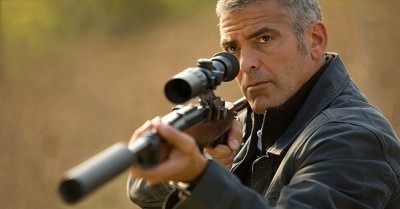The American
Directed by: Anton Corbjin
Starring: George Clooney, Thekla Reuten, Violante Placido, Paolo Bonacelli, Johan Leysen
Rated: R for violence, sexual content and nudity.
It’s been a long time since I sat in a theater and watched a film like “The American,” a film so quiet, spare, and thoughtful that it’s more of a cinematic meditation than a piece of entertainment.
The film’s plot is simple, and only half-explained. Our protagonist (George Clooney) is an assassin and a craftsman. Some Swedes want to kill him, so his handler, Pavel (Johan Leysen) has him hide out in a small Italian town and wait. A job comes through: Pavel wants him to build a custom weapon for a fellow assassin, Mathilde (Thekla Reuten). He does so. Meanwhile, a local priest (Paolo Bonacelli) befriends him, and a local prostitute, Clara (Violante Placido), falls for him.
All of this is told in short, spare conversations and long silent sequences. The occasional background music is so soft most of the time that if you see this in multiplex with an action flick showing next door, you will probably hear the explosions through the walls.
Our protagonist has no real name — he’s Edward to some people, and Jack to others. He’s a study in contrasts. He’s an assassin who is fascinated by butterflies, to the point that he has one tattooed on his back. He says he’s bad with machines, but he has a craftsman’s hands and he assembles the custom, complicated weapon for Mathilde with spare parts from a local mechanic and an rifle he orders through the mail. He’s not supposed to have friends, but he seems to be drawn into making them against his will. Pavel says he’s lost his edge, and as the film progresses, we can see it too.
He’s growing old, in spite of the daily exercise routine he follows. How long can a person live without love, enduring what the priest calls a life in hell, without cracking? Clooney has come a long way from his early days as the prettiest fellow on television. He crafts his performance as carefully as his character crafts the gun, his large, dark eyes telling us far more than his small, deflecting bits of dialogue. When the American meets Mathilde for the first time, their entire conversation is about the specifications of the weapon she wants; rather than a greeting, the first thing he says to her is, “range?” Later, when she tries to draw him out, he becomes monosyllabic. A lot of his conversations seem to end with him turning away without replying. And yet, we can watch the progression of his character in his eyes, in the way he walks, in what he doesn’t say.
“The American” is more a character study than a thriller. There are sudden, startling moments of violence, and long sequences of slowly increasing suspense, but if you’ve seen a handful of spy thrillers (particularly European ones), you know where this film is headed. That isn’t really important, though. This isn’t the kind of film you watch to find out what happens. Everyone knows how a sunset ends. That doesn’t make it any less beautiful.
